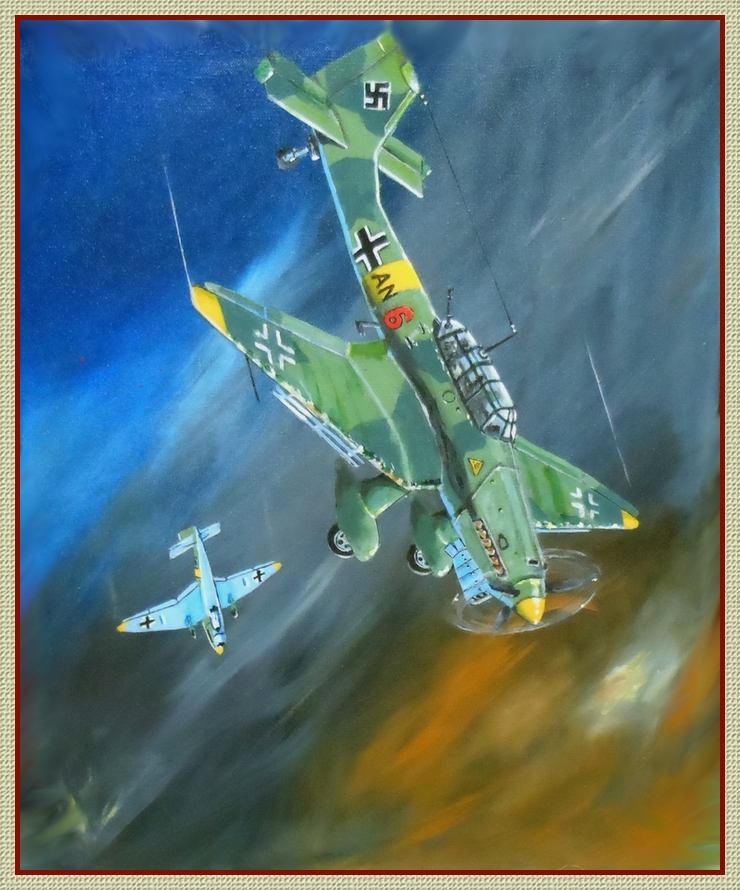 This is acrylic on canvas, depicting two early model Stuka dive bombers in attack mode. The Stuka’s were obsolete by the time WWII began, but the German High Command liked them as a terror weapon, mostly because of the screaming siren in a dive mode.
This is acrylic on canvas, depicting two early model Stuka dive bombers in attack mode. The Stuka’s were obsolete by the time WWII began, but the German High Command liked them as a terror weapon, mostly because of the screaming siren in a dive mode.
The Stukas were built to take a pounding. So, they were strong and very accurate with their payload, but they were not fast. This made them an easy target for a British Hurricane or Spitfire fighter. Ironically, despite their obsolescence, the German’s would not stop production of Stuka. In fact, they were around right up to the end of the war, even though by then they were hopelessly outgunned and slower than everything else in the air except for a kite or a balloon.
The Stuka could carry one 500 lb. bomb or one 250 lb. bomb and two smaller bombs mounted under each wing. Not an impressive bomb load, but remember, they were accurate and that scream they made in a dive made them a psychological weapon.
The colors scheme varied widely, depending on where they were deployed, the year and the squadron. The sky blue belly was very common. Notice the dive brake on the leading edge of the right wing? Actually they would be on both wings but you can’t see much of the dive brake on the left wing because of the angle.
This bomber carried a machinegun and gunner in the rear seat facing backwards and a pilot. The plane was strong enough to handle 6 g’s plus or minus…that’s a lot of g’s and most pilots would pass out if they tried it. However, the Stuka’s had a safety feature that automatically leveled the plane, if the pilot blacked out while pulling up from a steep dive, that was a handy gadget.
The fat wheel pants (fenders) were found most often on early 1936-39 versions, while the scoop on the cowling was found on newer versions. I took a little artistic liberty and combined the two variants in my version. Everything else is very authentic.
Few old war planes reflect the ugly, brutish and destructive side of war more than the infamous Stuka dive bomber. That’s why I picked it. I hope you will take a moment and just stare at the painting for 30 seconds. Note the cold and warm colors, the contrast, the dizzying background, the ghostly look to the Stuka, its all designed to evoke strong emotion. I think its one of my most powerful paintings to date. But, what do think, that’s what matters….did I succeed?
All comments welcome.

How far into the war were these planes used? This plane was pretty much helpless if fighters were around. And it seems fighters like the American P-47 were more effective for ground attack as they were less vulnerable and were effective with strafing and rocket attacks.
Joe, the Stuka was basically produced from 1935 thru 45, but it was considered obsolete by 1939 for reasons previously mentioned. However, there was one thing that made it a survivor in a dog fight. It was slow and thus it could turn tighter than either a Hurricane, P47, P38, P51 or a Spitfire. Other than that it was fresh meat for fighters.
The Stuka was a purpose built aircraft and very good for that purpose, but only that purpose. Stuka ace Hans-Ulrich Rudel destroyed over 500 Russian tanks during WWII.
Another weakness of the Stuka was that the engine was liquid cooled. The P47 had the 2000 HP Pratt and Whitney R-2800 air cooled radial engine. Joe, here is on of the best articles on the P47 I have found–
https://www.cradleofaviation.org/history/history/aircraft/p-47_thunderbolt_aviation_darwinism.html
Charles Mohrle, P47 pilot–
https://www.youtube.com/watch?v=Lo_irQ9bjzU
Great article. Thanks.
And video!